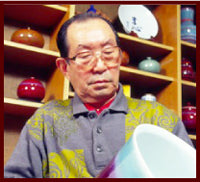Imari (Arita) Porcelain

Japan is a country that produces a lot of different ceramic types, most of them highly popular overseas. One these types if Arita ware, that has been favored over 400 years ago not only in Japan, but also in Europe. Later on, we will learn a little more about Arita ware and meet an aspiring, young ceramist.
In 1616, rumor has it, Ri Sanpei (a Korean ceramics who traveled to Japan from Korea) discovered a porcelain stone deposit at Izumiyama,in Atira. From there, he started working and made the first porcelain piece in Japan, with the use of the material he had discovered. With the porcelain stone, the production of ceramics quickly grew in Arita. With time, the overglazed techniques were so appreciated, that a magistrate's office was set up, in order to prevent them from leaking to outsiders, and in order to check on productions of Arite ware.
Early Arita ware design was mostly white material on blue designs. In the 1640s, the famous akae (a colorful overglaze that uses abundant red) was perfected by Kakiemon I. Beautiful designs in bright colors started to represent Arita ware, and from then on were loved all around the world. Still, in the 1690s the world saw the appearance of products that combined blue underglazed patterns, along with detailed overglaze patterns, with artifacts and gorgeous products, with gold applied over these incredibly fascinating designs. Known as Ko-Imari, this style of Arita ware had a significant influence on the productions of ceramics in a few areas of Europe.
With evolution at its peak, in less than one hundred years, akae and other techniques were perfected and brought up. In the 19th century, the reputation of Arite porcelains exploded in Paris, as they were shown at the Universal Exposition, granting them excellent reputation.
Nowadays, Arita is home to a lot of potteries, and a school that focuses basically in teaching the art of ceramics, in order to aspire future ceramists. Meinssen, Germany, entered a "sister city" contract with Arita in 1979, as both cities are famous for their porcelain (Meissen porcelain is the porcelain that originates from Meinssen). The international exchange through ceramics is a traditions kept alive even today.
Shinemon Kiln
Born in Shinchiro, Shinemon I started the Shinemon Kiln in 1972. Uncommon at the time, the Kiln aspired to create large ceramics. In the beginning, it applied sometsuke technique to his large pieces of work, 2 to 3 feet in height, with deep-blue underglaze drawing patters inserted into a white background. Nevertheless, his focus gradually went into the yohen technique, one that uses unexpected colors and patterns in the course of firing, depending on what chemicals the glaze is made out of. Nowadays, Shinemon mostly focuses on creating yohen ware with the slogan "brilliance of form, amazing effect of glaze", the yusai technique creates beauty in his art, and amazing color harmony.
Shinichiro Baba - Shinemon I

In 1972, Shinemon I, born Shinichiro, started the Shinemon Kiln, aspiring to create large-sized ceramics, which was uncommon at the time. At the beginning, he applied sometsuke technique to his large ceramics, 2 to 3 feet in height, drawing patterns in deep-blue underglaze on a white background. His focus, however, gradually shifted to yohen technique, where unexpected colours and patterns emerge in the course of firing, depending on the chemical composition of the glaze. His encounter with cinnabar, in particular, would have a tremendous effect on the future of the Shinemon Kiln. Today, the Shinemon Kiln mainly creates yohen ware, using glazes such as ruby-red cinnabar and crystal glaze, and, with the slogan of “brilliance of form, amazing effect of glaze,” boasts its yusai technique with layers of different glazes fusing together to create beautiful gradation of colours.
Kusuo Baba - Shinemon II

Born in the 19th of June, 1952, Kusuo Baba was an affiliate of Japan Fine Arts Exhibition, a member of Japan Contemporary Arts and Crafts Association (JCACA), and Arita Ceramic Art Association Director.
A brief history about Kusuo Baba - Shinemon II
1976 - Began his work in the Saga Ceramics Research Institute, where he learned about the basics of the craft, and started the study of glazes.
1981 - Initial member of JCACA Kyushu. Was strongly influenced by Ryuzan Aoki.
1997 - His work "Kokuei" was taken into the Japan Fine Arts Exhibition (and later on, it was accepted 14 times).
2004 - Submitted "Haruka wo Nozomu" and "Umibe No Uta" to the Arita Contemporary Ceramics.
2010 - In the 49th Japan Contemporary Arts and Crafts Exhibition, he was appointed as one of the examiners.
Steps in the Imari (Arita) Porcelain Process
1. Forming

After the clay is throughly wedged, it's formed by a pottery wheel, machine and hand.
2. Biscuit Firing

After the work has dried load it into the kiln. The firing is to approximately 1650 degrees F.
3. Underglaze Decoration

Underglaze is a method of decorating ceramic articles, the decoration is applied to the surface before it is glazed.
4. Glazing

The glaze is applied to the work.
5. Glaze Firing

The firing is to approximately 2400 degrees F in the Gas Fired Kiln.
6. On Glazed Decoration

Enamel decoration on the surface of a glaze which has already been fired
7. Decorating Firing

Once painted, the piece is fired a second time, at a lower temperature approximately 1300 degrees F.
8. Complete

Complete
